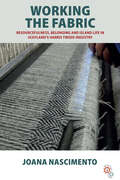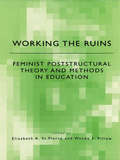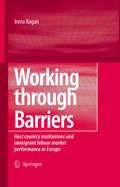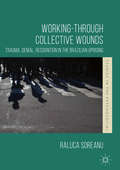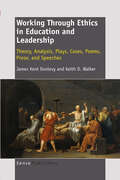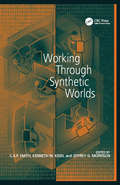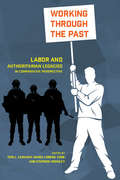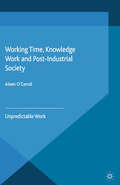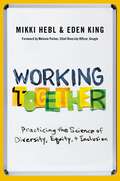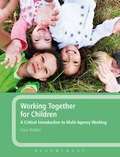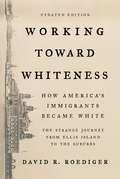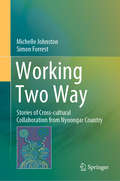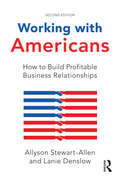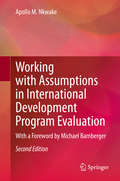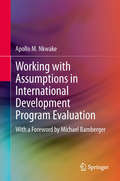- Table View
- List View
Working the Fabric: Resourcefulness, Belonging and Island Life in Scotland’s Harris Tweed Industry (Anthropology at Work #4)
by Joana NascimentoTrademark-protected since 1910, the famous woollen cloth known as Harris Tweed can only be produced in the Outer Hebrides of Scotland – yet it is exported to over 50 countries around the world. Examining contemporary experiences of work and life, this book is the first in-depth anthropological study of the renowned textile industry, complementing and updating existing historical and ethnographic research. Drawing on one year of ethnographic fieldwork research in the Outer Hebrides, it offers an intimate account of industry workers’ lived experiences and contributes to anthropological debates on work and labour, cultural production, inclusive belonging and place-making in global capitalism.
Working the Ruins: Feminist Poststructural Theory and Methods in Education
by Elizabeth A. St. Pierre Wanda S. PillowFirst published in 2000. Routledge is an imprint of Taylor & Francis, an informa company.
Working the Ruins: Feminist Poststructural Theory and Methods in Education
by Elizabeth St. Pierre Wanda PillowFirst published in 2000. Routledge is an imprint of Taylor & Francis, an informa company.
Working Through Barriers: Host Country Institutions and Immigrant Labour Market Performance in Europe
by Irena KoganThis book examines the role that institutional characteristics of host countries play in labour market integration of immigrants in the European Union. Drawing on existing research, it develops a comprehensive conceptual framework of factors and underlying mechanisms which affect immigrant integration in the fifteen nations that comprise the European Union. The author analyzes selected EU countries in depth, investigating the extent to which immigrants have succeeded or failed in different institutional contexts.
Working-through Collective Wounds: Trauma, Denial, Recognition In The Brazilian Uprising (Studies in the Psychosocial)
by Raluca SoreanuTrauma, Denial, Recognition In The Brazilian Uprising
Working Through Ethics in Education and Leadership: Theory, Analysis, Plays, Cases, Poems, Prose, And Speeches
by J. Kent Donlevy Keith D. WalkerThis book, although targeting educational leaders, - teachers, school-based administrators, superintendents, board members, policy makers and education students, is also addressed to those interested in the topic of ethics and those who seek the development of an ethical awareness and an appropriate intellectual processes when facing ethical issues. In particular, the book uses both deductive and inductive methods to provide the reader with a progressive experience of ethical discernment and analysis in order to deal with and prepare the reader to address ethical issues in the public square - a task which requires that such decisions are rational, defensible, and clearly articulated. Institutional leaders' diligence and integrity requires no less in attaining and sustaining the support of those they must lead in and through the institutional decisions and policies which effect constituents' lives. Through the use of clearly stated definitions, the presentation of ethical schools of thought, cases, original plays - within which readers are encouraged to engage while in a safe learning environment - and references to poems, movie, and video clips, the book provides a lively and challenging approach to studying the topic of ethics.
Working Through Synthetic Worlds
by Kenneth W. KisielVirtual environments (VE) are human-computer interfaces in which the computer creates a sensory-immersing environment that interactively responds to and is controlled by the behaviour of the user. Since these technologies will continue to become more reliable, more resolute and more affordable, it's important to consider the advantages that VEs may offer to support business processes. The term 'synthetic world' refers to a subset of VEs, having a large virtual landscape and a set of rules that govern the interactions among participants. Currently, the primary motivators for participation in these synthetic worlds appear to be fun and novelty. As the novelty wears off, synthetic worlds will need to demonstrate a favourable value proposition if they are to survive. In particular, non-game-oriented worlds will need to facilitate business processes to a degree that exceeds their substantial costs for development and maintenance. Working Through Synthetic Worlds explores a variety of different tasks that might benefit by being performed within a synthetic world. The editors use a distinctive format for the book, consisting of a set of chapters composed of three parts: ¢ a story or vignette that describes work conducted within a synthetic world based loosely on the question, 'what will work be like in the year 2025?', founded on the expert authors' expectations of plausible future technologies ¢ a scholarly review of the technologies described by the stories and the current theories related to those technologies ¢ a prescription for future research required to bridge the current state-of-the-art with the notional worlds described in the stories. The book will appeal to undergraduate and graduate students, professors, scientists and engineers, managers in high-tech industries and software developers.
Working Through Synthetic Worlds
by Kenneth W. KisielVirtual environments (VE) are human-computer interfaces in which the computer creates a sensory-immersing environment that interactively responds to and is controlled by the behaviour of the user. Since these technologies will continue to become more reliable, more resolute and more affordable, it's important to consider the advantages that VEs may offer to support business processes. The term 'synthetic world' refers to a subset of VEs, having a large virtual landscape and a set of rules that govern the interactions among participants. Currently, the primary motivators for participation in these synthetic worlds appear to be fun and novelty. As the novelty wears off, synthetic worlds will need to demonstrate a favourable value proposition if they are to survive. In particular, non-game-oriented worlds will need to facilitate business processes to a degree that exceeds their substantial costs for development and maintenance. Working Through Synthetic Worlds explores a variety of different tasks that might benefit by being performed within a synthetic world. The editors use a distinctive format for the book, consisting of a set of chapters composed of three parts: ¢ a story or vignette that describes work conducted within a synthetic world based loosely on the question, 'what will work be like in the year 2025?', founded on the expert authors' expectations of plausible future technologies ¢ a scholarly review of the technologies described by the stories and the current theories related to those technologies ¢ a prescription for future research required to bridge the current state-of-the-art with the notional worlds described in the stories. The book will appeal to undergraduate and graduate students, professors, scientists and engineers, managers in high-tech industries and software developers.
Working through the Past: Labor and Authoritarian Legacies in Comparative Perspective
by Teri L. Caraway Maria Lorena Cook Stephen CrowleyDemocratization in the developing and postcommunist world has yielded limited gains for labor. Explanations for this phenomenon have focused on the effect of economic crisis and globalization on the capacities of unions to become influential political actors and to secure policies that benefit their members. In contrast, the contributors to Working through the Past highlight the critical role that authoritarian legacies play in shaping labor politics in new democracies, providing the first cross-regional analysis of the impact of authoritarianism on labor, focusing on East and Southeast Asia, Eastern Europe, and Latin America. Legacies from the predemocratic era shape labor’s present in ways that both limit and enhance organized labor’s power in new democracies. Assessing the comparative impact on a variety of outcomes relevant to labor in widely divergent settings, this volume argues that political legacies provide new insights into why labor movements in some countries have confronted the challenges of neoliberal globalization better than others.
Working Time, Knowledge Work and Post-Industrial Society: Unpredictable Work
by A. O'CarrollWe are living in the age of imagination and communication. This book, about the new ways time is experienced and organised in post-industrial workplaces, argues that the key feature of working time within knowledge, and other workplaces, is unpredictability, creating a culture that seeks to insert acceptance of unpredictability as a new 'standard'.
Working to Be Someone: Child Focused Research and Practice with Working Children (PDF)
by Anne Wihstutz Antonella Invernizzi Beatrice Hungerland Bernard Schlemmer Brian Milne Deborah Levison Dieter Kirchhöfer Dominique Pierre Plateau Fabrizio Terenzio Hamidou Coly Jeylan Mortimer Jim Mckechnie Madeleine Leonard Manfred Liebel Maria Teresa Tagliaventi Martha Areli Sánchez Martin Woodhead Michael Bourdillon Nandana Reddy Phillip Mizen Sandy Hobbs Vinod Chandra Virginia Morrow William Myers Zandra Pedraza-GómezWorking to be Someone presents an overview of worldwide research on working children that considers children's own views of employment in favour of adult-constructed arguments about child work. This book brings together contributions by internationally renowned researchers who are committed to a 'subject-orientated' approach as well as views and observations of activists from organizations that either work with child labour or support working children's movements. Chapters examine the traditionally widespread care and domestic work carried out by children, discuss localized explorations of working children - for example in Morocco, India and Europe - as well as consider work as a means for children to contribute economically to the family. Contributors also discuss children's movements and organizations in Africa, Asia and South America that claim work as a necessity for survival as well as a key to children's own agency and citizenship. This book is a key text for both academics and social work practitioners that encourages re-evaluation of the notion of childhood and understands the complex phenomenon of working children.
Working Together: Practicing the Science of Diversity, Equity, and Inclusion
by Mikki Hebl Eden KingThe racial and gender reckonings exemplified by the #BLM and #MeToo Movements shine light on biases that affect every part of life, including the workplace. An unspoken truth underlying the terrible events that fuel these movements-the deaths of George Floyd and Breonna Taylor, acts of xenophobia against Asian people during the COVID-19 pandemic, the sexual violence perpetrated by Harvey Weinstein- is that people are being harassed, stereotyped, demeaned, and victimized in the context of work. Police officers and movie producers are perpetrators of terrible actions while they are working. What is happening in the American workplace to allow these events to unfold? And, of critical importance, what can leaders do to make lasting change? In this critical moment in our nation's history, organizational leaders have the opportunity and obligation to build strategy and practice in support of diversity, equity, and inclusion. This book will help all leaders rise to the challenge by describing state-of-the art science and practice. Expert scholars and professionals blend descriptions of case studies with large-scale robust evidence to help leaders recognize the imperative of diversity, equity, and inclusion in organizations, identify their own personal barriers and those of their organizations, and specify strategies for achieving positive and persistent change by working together.
Working Together: Practicing the Science of Diversity, Equity, and Inclusion
by Mikki Hebl Eden KingThe racial and gender reckonings exemplified by the #BLM and #MeToo Movements shine light on biases that affect every part of life, including the workplace. An unspoken truth underlying the terrible events that fuel these movements-the deaths of George Floyd and Breonna Taylor, acts of xenophobia against Asian people during the COVID-19 pandemic, the sexual violence perpetrated by Harvey Weinstein- is that people are being harassed, stereotyped, demeaned, and victimized in the context of work. Police officers and movie producers are perpetrators of terrible actions while they are working. What is happening in the American workplace to allow these events to unfold? And, of critical importance, what can leaders do to make lasting change? In this critical moment in our nation's history, organizational leaders have the opportunity and obligation to build strategy and practice in support of diversity, equity, and inclusion. This book will help all leaders rise to the challenge by describing state-of-the art science and practice. Expert scholars and professionals blend descriptions of case studies with large-scale robust evidence to help leaders recognize the imperative of diversity, equity, and inclusion in organizations, identify their own personal barriers and those of their organizations, and specify strategies for achieving positive and persistent change by working together.
Working Together For Children: A Critical Introduction To Multi-agency Working (PDF)
by Gary WalkerWorking Together for Children provides a factual and analytical introduction to the systems and processes of multi-agency work with children and families. It is for trainee practitioners in childcare, education, social work and health care, and for those going on to work, or already working, in such settings who are looking to be more effective practitioners. Reflection on practice is a theme running throughout the book. To assist readers with this, there are two types of feature: information boxes, giving further factual details of particular areas related to multi-agency work; and reflective exercises containing case studies, vignettes or statements, followed by questions designed to stimulate reflection on issues raised in the text. Readers should find Working Together for Children incredibly useful for having both an introduction to policy/frameworks and a full and critical evaluation of these in one place.
Working Toward Whiteness: How America's Immigrants Became White: The Strange Journey From Ellis Island To The Suburbs
by David R. RoedigerWorking Two Way: Stories of Cross-cultural Collaboration from Nyoongar Country
by Michelle Johnston Simon ForrestThis book describes an action research approach to engaging respectfully with First Nations communities in a diverse range of contexts, disciplines and projects. It offers a valuable guide for professionals, students and teaching staff that recognises all participants as equal partners while acknowledging the diversity of First Peoples and culture, and prioritising local knowledge. While the book is adaptable to a diverse range of cultures and disciplines, it is specifically focused on cross-cultural collaborative case studies in Noongar Country, which is located in the southwest of Western Australia. The case studies demonstrate how action research can be applied not only in the traditional areas of education and social justice, but also in a diverse range of disciplines, communities and circumstances, including media, education, environmental management and health. The book’s aim is to highlight successful cross-cultural First Nations community projects and to discuss each one in terms of its action research philosophy and process. In this regard, the voices of the participants are prioritised, especially those of First Nations communities. While this book is specifically pitched at Australian readers, the action research approach described may be adapted and applied to many cross-cultural collaborative relationships, making it of interest and value to international students and researchers.
Working with Adults At Risk of Harm (UK Higher Education OUP Humanities & Social Sciences Health & Social Welfare)
by Margaret Greenfields Roger Dalrymple Agnes Fanning"This important book brings together valuable resources and insights in a key area of practice which has often been overlooked, and where disadvantage and discrimination are rife, but which also deserves and demands serious attention of the kind offered here."Roger Smith, Professor of Social Work Research, De Montfort University, UKThis comprehensive book uniquely acknowledges the overlap between different states of adult vulnerability within a range of health, social care and community contexts. The book looks beyond social work practice and legislative focus to examine the categories of ‘at risk’ and ‘vulnerable adults’. These include often forgotten groups such as homeless people, prisoners and migrant workers.Through a range of practical examples, the book illustrates how professionals can usefully and effectively intervene to lessen the chance of a member of an excluded community becoming at greater ‘risk’ of further vulnerability. The book includes:Explanations of core themes and implications for a range of professionals and service providers with a practical and accessible focus Case studies and practice examples from work with vulnerable groups Illustrative examples of how different states of vulnerability are frequently contingent upon one another Working with Adults at Risk from Harm is ideal for third-year undergraduate students and Master's students in the fields of social work, social care, community health and education, as well as staff working in public sector who will have contact with vulnerable individuals in their professional life. Contributors: Jill Aitken, David Bailey, Jennifer Burton, Caroline Cole, Jo Edwards, Michael Farquharson, Lalage Harries, Tennyson Mgutshini, Melanie Parris and Kate Potter.
Working with Americans: How to Build Profitable Business Relationships
by Allyson Stewart-Allen Lanie DenslowAnybody who has ever done business with Americans can testify that there are more differences than similarities between the US business culture and those in the rest of the world. Whether it’s values, etiquette, communication, influencing or negotiating, there’s a clear American style. How you go about building successful and profitable business relationships in the US should be guided by the many important lessons and insights offered in this essential reference guide. Authors Allyson Stewart-Allen and Lanie Denslow capture the current US business environment in this second edition, providing you with a deeper understanding of America’s business mindset, diversity and regions so you can confidently navigate this large, complex and profit-making economy. Whether new to working with Americans or an experienced internationalist, this book will serve as your ready reference for connecting with US colleagues, clients, customers or consultants. You’ll discover what drives American informality, schedules and the desire to combine fun with business. Each independent chapter allows you to dip into specific topics or sections that interest you. All are grounded in evidence-based research on cross-cultural working, behavioral science and leadership. It’s the ultimate guide for busy business leaders regardless of sector or company size.
Working with Americans: How to Build Profitable Business Relationships
by Allyson Stewart-Allen Lanie DenslowAnybody who has ever done business with Americans can testify that there are more differences than similarities between the US business culture and those in the rest of the world. Whether it’s values, etiquette, communication, influencing or negotiating, there’s a clear American style. How you go about building successful and profitable business relationships in the US should be guided by the many important lessons and insights offered in this essential reference guide. Authors Allyson Stewart-Allen and Lanie Denslow capture the current US business environment in this second edition, providing you with a deeper understanding of America’s business mindset, diversity and regions so you can confidently navigate this large, complex and profit-making economy. Whether new to working with Americans or an experienced internationalist, this book will serve as your ready reference for connecting with US colleagues, clients, customers or consultants. You’ll discover what drives American informality, schedules and the desire to combine fun with business. Each independent chapter allows you to dip into specific topics or sections that interest you. All are grounded in evidence-based research on cross-cultural working, behavioral science and leadership. It’s the ultimate guide for busy business leaders regardless of sector or company size.
Working with Assumptions in International Development Program Evaluation: With a Foreword by Michael Bamberger
by Apollo M. NkwakeThis book discusses the crucial place that assumptions hold in conceptualizing, implementing, and evaluating development programs. It suggests simple ways for stakeholders and evaluators to 1) examine their assumptions about program theory and environmental conditions and 2) develop and carry out effective program monitoring and evaluation in light of those assumptions. A survey of evaluators from an international development agency reviewed the state of practice on assumptions-aware evaluation. This 2nd edition has been updated with further illustrations, case studies, and frameworks that have been researched and tested in the years since the first edition.Regardless of geography or goal, development programs and policies are fueled by a complex network of implicit ideas. Stakeholders may hold assumptions about purposes, outcomes, methodology, and the value of project evaluation and evaluators—which may or may not be shared by the evaluators. A major barrier to viable program evaluations is that development programs are based on assumptions that often are not well articulated. In designing programs, stakeholders often lack clear outlines for how implemented interventions will bring desired changes. This lack of clarity masks critical risks to program success and makes it challenging to evaluate such programs. Methods that have attempted to address this dilemma have been popularized as theory of change or other theory‐based approaches. Often, however, theory-based methods do not sufficiently clarify how program managers or evaluators should work with the assumptions inherent in the connections between the steps. The critical examination of assumptions in evaluation is essential for effective evaluations and evaluative thinking. "How does one think evaluatively? It all begins with assumptions. Systematically articulating, examining, and testing assumptions is the foundation of evaluative thinking… This book, more than any other, explains how to build a strong foundation for effective interventions and useful evaluation by rigorously working with assumptions." —Michael Quinn Patton, PhD. Author of Utilization-Focused Evaluation and co-editor of THOUGHTWORK: Thinking, Action, and the Fate of the World, USA. "This updated edition presents us with a new opportunity to delve into both the theoretical and practical aspects of paradigmatic, prescriptive, and causal assumptions. We need to learn, and apply these insights with the deep attention they deserve." —Zenda Ofir, PhD. Independent Evaluator, Richard von Weizsäcker Fellow, Robert Bosch Academy, Berlin, Germany. Honorary Professor, School of Public Leadership, Stellenbosch University, South Africa. “This thought-provoking book explains why assumptions are an essential condition within the theories and methodologies of evaluation; and how assumptions influence the ways that evaluators approach their work…It will enrich the ways that evaluators develop their models, devise their methodologies, interpret their data, and interact with their stakeholders.”—Jonny Morell, Ph.D., President, 4.669… Evaluation and Planning, Editor Emeritus, Evaluation and Program Planning
Working with Assumptions in International Development Program Evaluation: With a Foreword by Michael Bamberger
by Apollo M. Nkwake A major reason complex programs are so difficult to evaluate is that the assumptions that inspire them are poorly articulated. Stakeholders of such programs are often unclear about how the change process will unfold. Thus, it is so difficult to reasonably anticipate the early and midterm changes that need to happen in order for a longer-term goalto be reached. The lack of clarity about the “mini-steps” that must be taken to reach a long-term outcome not only makes the task of evaluating a complex initiative challenging, but reduces the likelihood that all of the important factors related to the long term goal will be addressed. Most of the resources that have attempted to address this dilemma have been popularized as theory of change or sometimes program theory approaches. Although these approaches emphasize and elaborate the sequence of changes/mini steps that lead to the long-term goal of interest and the connections between program activities and outcomes that occur at each step of the way, they do not do enough to clarify how program managers or evaluators should deal with assumptions. Assumptions, the glue that holds all the pieces together, remain abstract and far from applicable. In this book the author tackles this important assumptions theme head-on-covering a breadth of ground from the epistemology of development assumptions, to the art of making logical assumptions as well as recognizing, explicit zing and testing assumptions with in an elaborate program theory from program design, implementation, monitoring and evaluation.
Working with Children in Care: European Perspectives (UK Higher Education OUP Humanities & Social Sciences Health & Social Welfare)
by Pat Petrie Janet Boddy Claire Cameron Valerie Wigfall Antonia SimonHow does residential care in England compare with that of other European countries? What is social pedagogy, and how does it help those working with children in care?How can child care policy and practice be improved throughout the United Kingdom? This book is written against the background of the gross social disadvantage suffered by most looked-after children in England. It compares European policy and approaches – from Belgium, Denmark, France, Germany and the Netherlands – to the public care system in England. Drawing on research from all six countries, the authors analyze how different policies and practice can affect young people in residential homes. A particular focus is on the unique approach offered by social pedagogy, a concept that is commonly used in continental Europe. The book compares young people's own experiences and appraisals of living in a residential home, and the extent to which residential care compounds social exclusion. Based upon theoretical and empirical evidence, it offers solutions for current dilemmas concerning looked-after children in the United Kingdom, in terms of lessons learned from policy and practice elsewhere, including training and staffing issues.Working with Children in Care is key reading for students, academics and professionals in health, education and social care who work with children in residential care.
Working with Community Groups: Using Community Development as a Method of Social Work ILS 198 (International Library of Sociology)
by George W GoetschiusA report of the development of a service to housing estate community groups by the London Council of Social Service, based on 15 years of field work experience using the community development approach and method. First Published in 1969. Routledge is an imprint of Taylor & Francis, an informa company.
Working with Critical Realism: Stories of Methodological Encounters (Routledge Studies in Critical Realism)
by Alpesh Maisuria Grant BanfieldThis international and interdisciplinary collection gathers stories from researchers and research students about their methodological encounters with critical realism. Whether the contributors are experienced or novice researchers, they are predominantly new to critical realism. For various reasons, as the contributors’ detail, they have all been drawn to critical realism. It is well known that critical realism can be bewildering and even overwhelming to newcomers, especially to those unfamiliar with language of, and without a grounding in, philosophy. While there are now numerous and important introductory and applied critical realist texts that make critical realism more accessible to a broader audience, stories from newcomers have been absent – especially as part of a single collection. The significance and uniqueness of this collection lies in its documentation of first-hand reflective insights on the practical use and implementation of critical realism. The contributors feature critical realist inspired research journeys in Australia, England, Scotland, Belgium, Sweden, and Spain. The hope of this book is that the stories and accounts presented in it will inspire – or at least sufficiently arouse – the curiosity of others to explore critical realist possibilities, which we believe offer enormous value to serious researchers across and within all disciplines and subjects who are interested in rigorous intellectual work with a socially progressive purpose.
Working with Critical Realism: Stories of Methodological Encounters (Routledge Studies in Critical Realism)
by Alpesh Maisuria Grant BanfieldThis international and interdisciplinary collection gathers stories from researchers and research students about their methodological encounters with critical realism. Whether the contributors are experienced or novice researchers, they are predominantly new to critical realism. For various reasons, as the contributors’ detail, they have all been drawn to critical realism. It is well known that critical realism can be bewildering and even overwhelming to newcomers, especially to those unfamiliar with language of, and without a grounding in, philosophy. While there are now numerous and important introductory and applied critical realist texts that make critical realism more accessible to a broader audience, stories from newcomers have been absent – especially as part of a single collection. The significance and uniqueness of this collection lies in its documentation of first-hand reflective insights on the practical use and implementation of critical realism. The contributors feature critical realist inspired research journeys in Australia, England, Scotland, Belgium, Sweden, and Spain. The hope of this book is that the stories and accounts presented in it will inspire – or at least sufficiently arouse – the curiosity of others to explore critical realist possibilities, which we believe offer enormous value to serious researchers across and within all disciplines and subjects who are interested in rigorous intellectual work with a socially progressive purpose.
